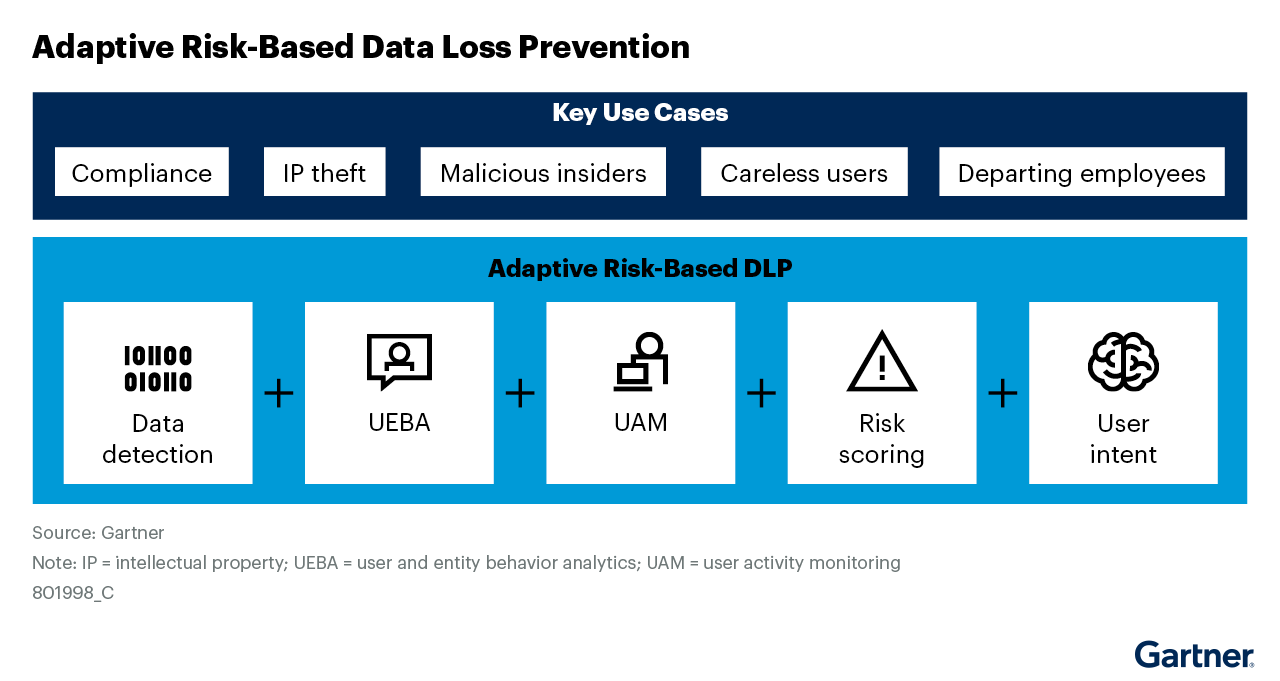Data Loss Prevention (DLP) solutions have been around for decades and not surprisingly have become an enterprise security staple. But while the market has certainly evolved, most data protection products on the market continue to struggle with the practical useability of content-focused tools. And perhaps more importantly, they ultimately miss the critical piece that can stop a data loss event—identifying intent early.
In the Gartner 2025 Market Guide for Data Loss Prevention, it mentions, “Traditional DLP solutions focus more on content and are data-centric, so they cannot easily distinguish between malicious and accidental data disclosure.”
While this has been said before, the question now is what are we doing about it?
What is risk adaptive DLP?
Recent trends acknowledge the need for both context and content inspection in DLP platforms, making them more dynamic and adaptive. But many vendors claim ‘risk adaptive’ DLP without having the quality data or AI-driven analytics required for such an approach. DTEX behavioral DLP addresses this by layering market-leading user behavior intelligence and user activity monitoring (UAM) with our DLP capabilities—the trifecta for effective insider risk management (IRM). Gartner includes a graphic on page 8 of the report that sums it up perfectly:

This combination of functionality allows DTEX to provide a much needed, nuanced understanding of data interactions and user intent, improving the accuracy of early ‘risk detection’ and making mitigation easier. With alert stacking and AI-powered activity scoring algorithms, DTEX InTERCEPTTM accurately scores deviations that precede data loss events. Understanding the detailed steps taken up to and during an attack, especially slow-moving threats, plays a big part in preventing a data loss incident. The Gartner 2025 Market Guide for Data Loss Prevention suggests that “By 2027, organizations incorporating intent detection and real-time remediation capabilities into DLP programs will realize a one-third reduction in insider risks.” The connection between risk-adaptive DLP and reducing insider risk is clear.
DLP and security stack consolidation
The evolution of the market is good for organizations seeking more versatile and cost-effective DLP options that simultaneously reduce insider risk while data exfiltration vectors are growing. According to Gartner, “By 2027, 70% of CISOs in larger enterprises will adopt a consolidated approach to address both insider risk and data exfiltration use cases.”
The DTEX platform provides a consolidated approach to stopping a data breach. By integrating DLP with IRM, organizations can create a comprehensive data protection strategy that not only safeguards sensitive information but also proactively identifies and mitigates risk before a data loss event can occur. This consolidated approach is particularly useful given the growing number and complexity of security tools.
Why should I align DLP strategy with business initiatives?
DLP projects that are not tied to broader business-driven initiatives or use cases often indicate an absent or immature data security governance program. Relying solely on technology solutions leads to unclear or missed use cases and requirements, complicating tool selection, and reducing the chances of project success. It’s important to define DLP strategies that align to the organization’s business initiatives and data security governance best practices by identifying key business outcomes and selecting DLP products that enable and support them.
At DTEX, we understand that data security is not just about stopping a breach—it’s about enabling business outcomes. Each component of the security ecosystem should work together to provide comprehensive data protection that aligns with the organization’s goals. Through AI innovation and incorporating intent detection and real-time mitigation strategies into DLP programs, organizations can realize a significant reduction in insider risks. This proactive approach to data security ensures that DLP projects are effective and produce broader business success.
Conclusion
As DTEX continues to innovate in the field of data security, we believe that a more flexible, consolidated approach to DLP will move the market into the next era and better protect an organization’s crown jewel data. By aligning DLP projects with business-driven initiatives and selecting tools that support risk adaptive techniques, organizations can more effectively navigate the complexities of modern data security. To learn more about the value of DTEX InTERCEPT download the Forrester Total Economic Impact Study and request a demo.
For a deeper dive into these insights and recommendations, read the full Gartner 2025 Market Guide for Data Loss Prevention.
Gartner, Market Guide for Data Loss Prevention, Andrew Bales, Franz Hinner, Anson Chen, Paulo Aresta, Brent Predovich, 9 April 2025
GARTNER is a registered trademark and service mark of Gartner, Inc. and/or its affiliates in the U.S. and internationally and is used herein with permission. All rights reserved. Gartner does not endorse any vendor, product or service depicted in its research publications, and does not advise technology users to select only those vendors with the highest ratings or other designation. Gartner research publications consist of the opinions of Gartner’s research organization and should not be construed as statements of fact. Gartner disclaims all warranties, expressed or implied, with respect to this research, including any warranties of merchantability or fitness for a particular purpose.
Subscribe today to stay informed and get regular updates from DTEX Systems






